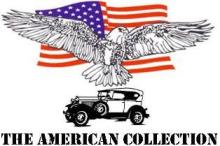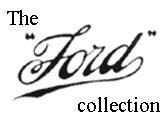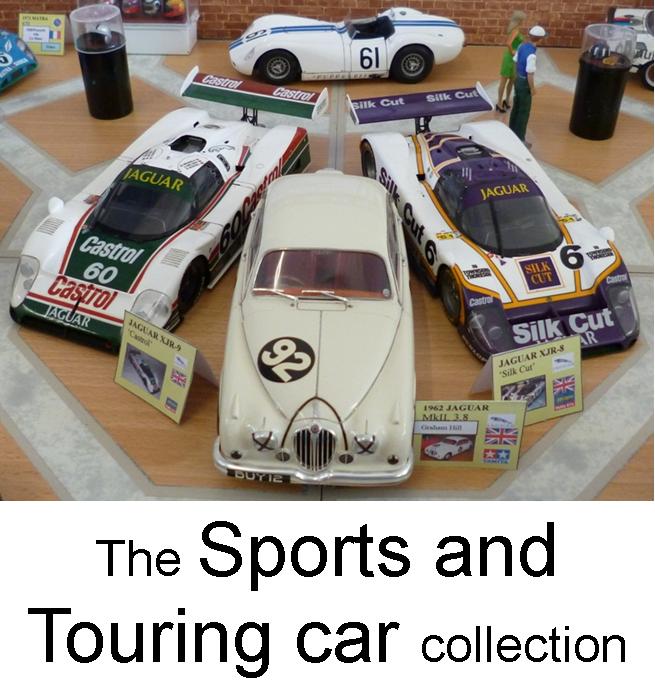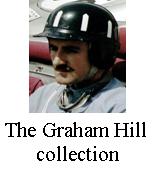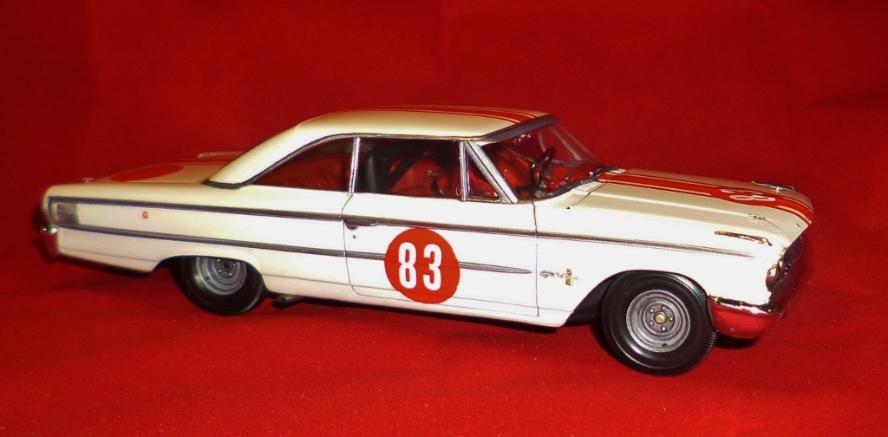
1963 FORD GALAXIE 500 R-code 'lightweight'.
In the early 1960s Ford started a total performance program to raise the image of Ford cars from staid reliable family vehicles to exciting sporty performance cars. This initiative would, in time, bring Ford multiple NASCAR Manufacturers Championships, World Rally Manufacturer Championships and outright victories at the Le Mans 24 Hours. Ford backed engines also powered multiple F1 drivers to their championships and all the competition success elevated the Ford brand to the highest levels; beating Ferrari, Jaguar, Porsche and others, all around the world.
In Britain the premier championship for saloon racing in the British Touring Car Championship (BTCC), or as it was known back in the 1960s, the British Saloon Car Championship (BSCC). This championship would be the ideal place for Ford to attack the British market with their total performance philosophy. At the time the Jaguar XK-engined Mk1 and then Mk2 saloons ruled the roost, beating them would be quite coup.
The Ford project included their co-operation with Lotus in the Cortina program and more astoundingly with John Willment’s experiment with the NASCAR stock-car racing Galaxie, a 400hp, 7ltr, giant of a car much bigger than anything on the British circuits of the day.
The start of the project
Twickenham Ford dealer John Willment was thinking of setting up a racing team, something good for the business profile and possibly some fun too, when he was approached by the Ford Motor Company of America to run one of their Galaxies in Britain. Not just any Galaxie but a full on “Holman & Moody ‘R-Code’ Lightweight NASCAR Ford Galaxie”.
Although Ford commissioned approximately 210 ‘Lightweight’ ‘R-Code’ 427 Galaxy 500s from Holman & Moody, of Charlotte, North Carolina, USA, only three cars were destined for the BSCC. The first chassis being no. 3N66R143030 for the Willment racing team; the other two went to Sir Gawaine Baillie and the private entry Alan Brown racing team. All the cars were Corinthian White with red vinyl interior.
At the time Ford UK had the new Lotus Cortina on track, and Willment was certainly behind that car, but that was a British car and had little chance of competing with the all-conquering Jaguars of the era. The idea of a huge 7Ltr V8 engined, “Yank tank” competing in the BSCC was more likely to get the job done when it came to overall wins; and that certainly appealed more than fielding the Cortina which would most likely only be a contender in under 2-liter class.
The ‘427cu’in’ dual-carburettor engine in the Galaxie was also helped by the fitting of a medium-rise intake manifold and Y-piece fabricated exhaust primaries, to the Belanger Brothers design, which fed out through the chassis rails to oval side exit pipes. All of which added engine breathing and increased the power.
The 1963 Ford Galaxie 500 was huge car, and not just in engine capacity. These cars were 30in’ longer and 13in’ wider than 3.8 Mk II Jaguar, and that wasn’t a small car by British standards. They needed the advantage of horsepower too, 400hp over the Jaguar’s 220hp, as the Galaxie 500 was around 300Lbs heavier than the Jag’s.
The cars had a four-speed Borg-Warner T10 gearbox and a rear axle ratio of 4.11:1. They were certainly fast in a straight line, but few British BSCC circuits had long straights. Willment’s racing team staff had more concerns about braking, turning; and clutch fragility. Nascar has rolling starts and the first gear ratio was high, in BSCC standing starts were the norm and there were lots of tight corners requiring a higher level of gear changing than the American oval circuits.
However, the Holman-Moody design team had done a lot of work on the ‘Lightweight’ Galaxie’s and the suspension was improved with stronger pick-up points, stiffer springing and wishbones as well as doubled shock absorbers. Heavy duty anti-roll bars were also employed to keep wallowing under control. Weight was significantly reduced by the removal of steel panels in exchange for a fibreglass bonnet, boot and front wings, bumpers were fabricated from aluminium as were the transmission cases and bellhousings. All the sound deadening material was removed too. Amazingly the Galaxie still came out 375 lbs lighter!
Interestingly the Galaxie kept its drum brakes and the same clutch. But these also had a level of compensation because of the Nascar developed tyres. Jaguar wheels had 15 x 5in’ tyres giving a contact patch of 5.5 inches. The Galaxie ran on new 15 x 7in’ Firestones “wide oval” tyres putting 8in’ of tread on the track surface. This additional grip area helped vastly in braking and turning as well as translating the available horsepower into traction and acceleration. All of which more than made up for any wallowing and loss of speed through the corners.
Going racing
With the team set up and car decided upon the driver was next on the agenda. John Willment Automobiles team manager, Jeff Uren, placed a call to 1958 BSCC Champion “Gentleman” Jack Sears, a very popular driver and former racing rival of Uren’s. Sears wasn’t just a veteran saloon car racer with multiple race wins and championships but also had class wins at the le Mans 24hrs, the Daytona 24hrs too, a highly adaptable, dependable and successful driver any team would be glad to have on their staff. Jeff Uren explained the new team had acquired the Galaxie and a couple of Cortinas. This was important as the Championship's under 2ltr class winner was to get equal points to the overall winner so even if the Galaxie was out of action then the Cortina still kept the driver in the championship standings.
'Gentleman Jack' discussed the Willment offer with his wife and then decided to sign for the new team with the comment "It sounded like fun...".
Round five of the 1963 British Saloon Car Championship
The Galaxie had arrived in Britain via a US Airforce Transport plane (alongside a large delivery of Coca Cola for the USA air bases in England), after being driven the 600 miles from North Carolina to New York. The Holman & Moody receipt, No. 814, confirms not only the delivery details of "John Willment Automobiles Ltd, 161 Chertsey Road, Twickenham, Middlesex, England” but also the original price in USD $3,342.98.
With just a few days to get the car to Silverstone for round five of the 1963 BSCC as part of the 15th International Trophy Meeting on the 11th of May 1963 Willment racing had a lot of pre-race checks and preparation to do. Including phone calls from Jeff Uren to John Holman back in Charlotte, NC, to ask how strong the clutch would be around the British tracks. Holman basically said don’t dump the clutch it won’t take it.
The race proved to be a stunning result for the team, and BSCC as a whole. “Gentleman” Jack was a little concerned at first but after qualifying felt much better. He recalled “Without trying terribly hard I then qualified on pole position, faster than all the Jaguars.”
At the race start Jack knew look after the clutch and made a very safe start seeing the Jaguars of Graham Hill, Roy Salvadori and Gawaine Baillie stream past him into the first corner. But Jack was not surprised by that. He was surprised when he caught and overtook all three in one move. As Jack Sears recounts it “In that first race I had drum brakes with metal-to-metal linings so they didn’t fade and were actually quite good, better than you would believe. I found the Jaguars were not out-braking me, so when we left Chapel Corner and came onto ‘Hanger straight’ I felt, gosh, this thing is really flying, I think I can pass them. To my surprise I passed all three Jaguars in one manoeuvre. I had no time for waving or anything like that; I had my head down concentrating but now was the moment of truth as I hit my braking point for Stower. To my surprise they didn’t come past me but just followed me. I put my foot down in the exit from the fast-uphill left-hander Abbey and the Galaxie just pulled away from the Jaguars. By the end of the second lap I had a comfortable lead though was still worried about the clutch, so left the Galaxie in fourth gear for the rest of the race – I never changed gear again …”.
At the halfway point Sears and his ‘Yank Tank’ already had 20sec’s lead over Roy Salvadori and the other Jaguar drivers who could do little more than hope the Galaxie broke down as they couldn’t compete with its horse power advantage. Jeff Uren gave Sears the ease-up signal which he did, having set a new touring car lap record of 92.42mph, and the car held itself together to take the victory. The first that season that wasn’t taken by a Jaguar.
The pattern repeated itself with Jack winning every time he finished with the Galaxie that year, taking the BSCC drivers title from John Whitmore who drove an Austin Mini Cooper S for the Cooper Works team, and Graham Hill who was third in the standings. Hill’s 3rd place was quite an achievement considering he couldn’t participate in all the events and drove several different cars that season.
One of those cars was the Willment Galaxie which he drove to 2nd place in the Oulton Park gold cup meeting BSCC race in September, 1963. As there were plenty of F1 drivers around many were in the BSCC cars that day, including Dan Gurney in Alan Brown Racing's rival Galaxie and Trevor Taylor in the Team Lotus Cortina. Those three taking the front row of the grid in the order Gurney, Hill, Taylor. Jack sears was next in a new Cortina. Autosport magazine reported the race the thus :
"Dan Gurney made a thunderous start with rear wheels spinning madly, but Graham Hill in his gigantic bolide took it easier and was out-accelerated by Sears and Taylor, and Adams's Jaguar. However, on ['Knickerbrook'] Straight Hill boomed past the trio in the Willment device to take second place. "Gurney was completely master of the race, using the immense acceleration of his drum-braked monster to the limit, with a conspicuous absence of wheel-winding and tearaway cornering – in fact the perfect example of a polished performance. Less familiar with the Galaxie, Graham Hill was not exactly hanging around, but gradually fell back to be pursued by the incredible Lotus-Cortinas of Sears and Taylor... Gurney gradually overwhelmed the rest of the field, and when he crossed the line at the end he was 31secs in front of Hill, and the only others on the same lap were Sears, Taylor and Salmon."
Graham Hill reprised his drive with the Willment Galaxie putting it on the podium again in the 1964 Oulton Park Gold Cup Meeting.
At the end of the 1963 BSCC season the championship standings were as followed:
1st - Jack Sears. John Willment Automobiles Ford Galaxie and Cortina
2nd - John Whitmore. Cooper Works team. Austin Mini Cooper S
3rd - Graham Hill. Largely driving the John Coombs Jaguar. (Despite not competing in all the rounds), Hill also took the Class D driver's championship.
In winning this Championship Jack Sears became the first person to take a second BSCC title and the first driver to win a championship using three different cars.
More racing for 'BML 9A'
The John Willment Racing Galaxie then raced in South Africa over the UK ‘off season’ before the 1964 BSCC season once again showed the Galaxie to be a Jag beater. But the Cortina was now the rising star and John Willment Automobiles took the car on the continent for the Europen Touring Car Championship. Winning in dominant fashion at Zolder. Sears drove the Cortina more often in the BSCC and Jjm Clark took the title in the Team Lotus Cortina. After the BSCC season the Willment Galaxie again went off to South Africa where it was again campaigned by Bob Olthoff.
However, the cars colours were reversed to red with white stripes. Olthoff purchased the car from Willment to continue racing it in SA through the 1965 season. After many notable wins Olthoff decided he would keep the car in his personal collection where it remained until 1988 when he finally gave in to Jack Sears requests to buy the car.
In the end
On receiving the car Sears had it returned to its original White with red stripes scheme and UK registration number ‘BML 9A’. The car was further restored in the 1990s when Sears had Mike Brown, formerly the Willment team engineering manager to take on the task at his own shop, Rally Service Ltd. in Middlesex. At the same time the engine was also rebuilt in ‘The Engine Shop’ of Maids Moreton, Buckingham.
“Gentleman” Jack Sears sentimental attachment to the car kept it in his personal collection until he passed away and the car was sold as part of his estate in 2017 appearing many times at the Goodwood Festival of Speed and Revival meetings; at the personal request of Lord March.
Legacy
John Willment Automobiles Ltd racing team's Ford Galaxie ‘Lightweight’, chassis no. 3N66R143030, UK registration no. BML9A, was sold by Bonhams at the Goodwood Revival auction in Chichester, U.K., on the 9th of September, 2017. It fetched a price of $623,561, a considerable sum of money for a Ford Galaxie 500, which are far from uncommon cars.
But what the money bought was so much more than a car. This car has history oozing out of it. The List of drivers reads like a who’s who of British motorsport,
Jack Sears - three-time British Saloon Car Champion
Graham Hill, - Double Formula One World Champion
Bob Olthoff, - 1965 South African Touring Car Champion
Paul Hawkins - Targa Florio winner, and the great
Frank Gardner.
'BML 9A' won the British Saloon Car Championship and South African Saloon Car Championship, as well as a whole slew of other races across the world. It is by far the most successful of the BSCC ‘R-Code’ Galaxies and the only one to survive in almost original condition. More than all that, this was the car that spectacularly broke Jaguar’s strangle hold on the BSCC and opened the way for Ford Falcon V8s and Mustangs. It is a particularly important landmark car that left an indelible mark on the history of saloon and touring car racing in Britain.
However, it is perhaps the sentimental value that commands the real respect. Both Championship winning drivers loved the car so much they both chose to purchase it and keep it in their own personal collections.
Our model is presented as it raced in the 1963 Oulton Park BSCC event driven by the then reigning F1 world champion, Graham Hill, points which helped him secure the Class D BSCC driver’s championship.





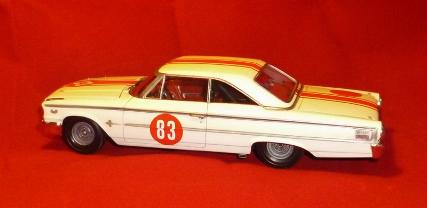
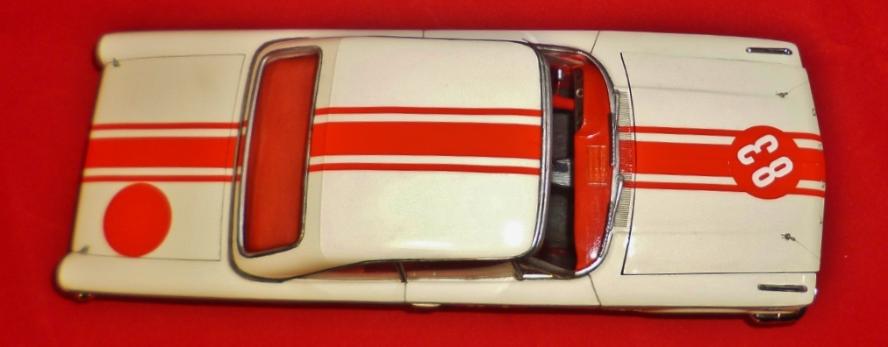
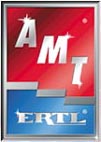





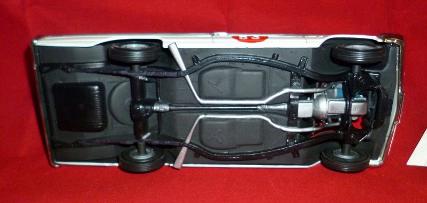
1/25th Scale AMT 1963 Ford Galaxie 500 Prestige series kit # 6501. Released in 1987, it is a re-boxing (having new and/or updated parts), of the original AMT '63 Hardtop New Ford 500 XL Sports Hardtop, kit # 6123-200, initially released new in 1962. Confused? It’s because the American automobile manufacturers often presented their new lines for the coming year in the autumn of the preceding calendar year. The kit manufacturers then worked with the car companies to make ‘promo’ kits to help stimulate interest in the brands new model line-up for the following year.
Ian built this model in September/October 2022 for the IPMS Stafford Branch display at that years IPMS (UK) “Scale Model World” show. This build also marks the period of mourning for Her Majesty Queen Elizabeth the second, who passed away on the 8th of September, 2022. Having every intention of making the model straight from the box, but for the livery, he soon found this couldn’t be done in fairness to the subject. Changes began on the inside with the roll hoop and the double supports which appear to pass through the rear seat.
The driver’s seat was pared back to expose the frame, the passenger seat is still covered with the outer covers on the other seat. The driver’s side door had its arm rest removed too. The dash board had to be re-worked as it needed a different set of dials to the road car. Interestingly the dash area was all blacked out and prepared to avoid and glare too.
On the exterior the rear fuel filler space had to be opened and the pipe and cap parts scratch built, also scratch built were the side exiting exhausts; something that meant the removal of the moulded-on exhausts from the floor plan, a job which took three hours each side in order to preserve the appearance of the smooth floor panels. Finally, some scratch-built bonnet and boot pins were added and side windows not provided in the kit fitted, including the driver’s side quarterlight being made to be in the open position as in photo references of the car in the race.
The body is painted with Zero paints Ford white Clear coat by Kustom Service KSM 1000 Extreme Ultra Gloss. The interior is all brush painted with Humbrol enamels to get the texture of the vinyl. The carpet is all acrylic matt black, again, brush applied. Decals from Fantasy Print Shop were used for the stripes, FP602 Signal red, and FP209 Red, for red roundels; numbers came from the spare decals box. Interestingly, in some photo’s the car has red roundels and others they are black. I’m assuming that different series, like the South African series or in rallying, the rules about coloured roundels were different.
The compressed registration number plates had to be made using the set from Modelworks, sheet # MSMD243, set on black decal paper. Not soaked off just with the edges painted black to create a ‘plate’. Attached with Deluxe Materials Glue’n’Glaze then sealed with ‘Klear’.
RETURN TO :-
